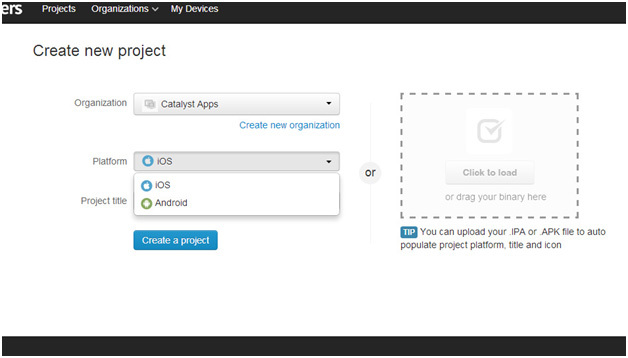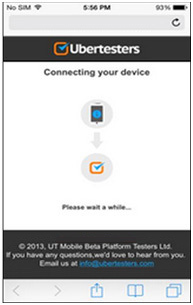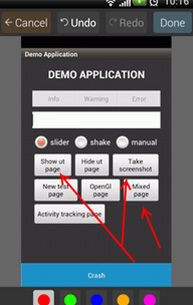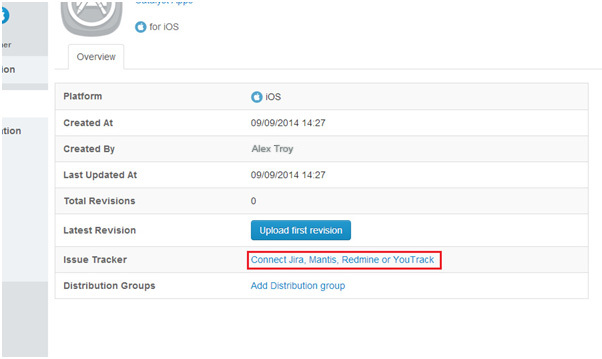Platform for testing mobile applications Ubertesters: implementation experience
While ordinary users are waiting for their next iPhone, and ASUS is announcing a new tablet, I would like to share one day in the life of a mobile application developer.
Like other small development companies, ours faced a banal shortage of people for manual testing of written applications. With the increase in the number of projects, the number of unordered files with bug reports has grown. The lack of a normal build management system and submission of bugs has become a serious problem.
We spent some time with TestFlight for distributing builds and crash reports, which was very convenient. But, as already mentioned on Habré , TF swallowed Apple, so the platform instantly stopped supporting Android. In search of an alternative, we switched to Ubertesters - not least because of the month of the free trial version.
The principle of operation is extremely simple:
')
1. Create an organization and project on the platform;
2. Integrate the SDK with our build;
3. Download the build;
4. Add a device;
5. Add participants to the project - devs, testers, someone else;
6. Share the build with users;
7. The tester installs the application on the device;
8. The tester sends reports with attached screenshots of bugs;
9. Bugs fix;
ten. ???????
11. PROFIT
First of all, in the working environment we need to create an organization from which applications come in for testing (see screenshot). An organization is a set of projects written by developers for different devices.

We create a project inside the organization for each new application. To do this, we need to choose under which OS our application was developed - iOS or Anfroid. You can simply drag the .apk or .ipa file into the window.

What should I look for when working with iOS? The device UDID must be added by the developer in Provisioning profile in iTunes. If the device is not added to the profile or the wrong UDID is added, the tester will not be able to install the build.
In order to start using Ubertesters, download and integrate the SDK we need. If you are writing a cross-platform application, then among the supported frameworks there are also Xamarin, Unity, PhoneGap, and by the time of the submission of this publication it was also announced that Adobe Air is supported.
Add to your project devices with the appropriate OS.

After connecting and configuring devices, we invite participants to the project - developers, testers and RMs. If we need, for example, to collect statistics for any particular category of users, then we create for them a separate “distribution group” and form it as we please.

When new builds are released, testers added to the project receive push notifications, download the build through their device and do the actual testing.
A bit unusual after TestFlight, but on the whole a convenient system, besides the feature set standard for such platforms, also has a set of features for faster feedback from the tester. Yes, and the testers themselves bugs now submit directly from the device with the accompanying screenshots and descriptions. Before, we faced the same stupid problem: testers spend more time reporting on themselves than not testing. The bug-report came at best in the form of a text description, after which it was necessary to clarify for a long time and painstakingly exactly where the error got out. The built-in screen editor in the SDK elegantly solves this problem - the tester simply takes a screenshot directly on the device itself, circles it or draws an arrow to it and sends it to the submission. Very clearly. In addition to the screen itself, all the necessary information about the device is automatically collected - model, axis, screen resolution, etc.

You can also export bug reports to other bug trackers, which is very convenient for those who work, for example, via Redmine or Jira.

It is also possible to track the sessions of each individual device or project participant, check how long the session was active, and how much - just hung "in the background." Although we didn’t use this feature, I think it would be an ideal solution for RMs who are paranoidly trying to control the entire development and testing process.
After a month of successful use of the trial version of Ubertesters, the speed and quality of testing our applications has increased significantly. In general, the Ubertesters platform is a solid, comparable to Tesflight service with a number of additional features, such as support for test cases, build management, as well as automatic upload of device data. You do not need to send any more revisions by mail - the tester receives all notifications automatically.
It would be interesting if in the comments you share your experience of using similar platforms, what advantages they have, and what problems you face.
Like other small development companies, ours faced a banal shortage of people for manual testing of written applications. With the increase in the number of projects, the number of unordered files with bug reports has grown. The lack of a normal build management system and submission of bugs has become a serious problem.
We spent some time with TestFlight for distributing builds and crash reports, which was very convenient. But, as already mentioned on Habré , TF swallowed Apple, so the platform instantly stopped supporting Android. In search of an alternative, we switched to Ubertesters - not least because of the month of the free trial version.
The principle of operation is extremely simple:
')
1. Create an organization and project on the platform;
2. Integrate the SDK with our build;
3. Download the build;
4. Add a device;
5. Add participants to the project - devs, testers, someone else;
6. Share the build with users;
7. The tester installs the application on the device;
8. The tester sends reports with attached screenshots of bugs;
9. Bugs fix;
ten. ???????
11. PROFIT
First of all, in the working environment we need to create an organization from which applications come in for testing (see screenshot). An organization is a set of projects written by developers for different devices.

We create a project inside the organization for each new application. To do this, we need to choose under which OS our application was developed - iOS or Anfroid. You can simply drag the .apk or .ipa file into the window.

What should I look for when working with iOS? The device UDID must be added by the developer in Provisioning profile in iTunes. If the device is not added to the profile or the wrong UDID is added, the tester will not be able to install the build.
In order to start using Ubertesters, download and integrate the SDK we need. If you are writing a cross-platform application, then among the supported frameworks there are also Xamarin, Unity, PhoneGap, and by the time of the submission of this publication it was also announced that Adobe Air is supported.
Add to your project devices with the appropriate OS.

After connecting and configuring devices, we invite participants to the project - developers, testers and RMs. If we need, for example, to collect statistics for any particular category of users, then we create for them a separate “distribution group” and form it as we please.

When new builds are released, testers added to the project receive push notifications, download the build through their device and do the actual testing.
A bit unusual after TestFlight, but on the whole a convenient system, besides the feature set standard for such platforms, also has a set of features for faster feedback from the tester. Yes, and the testers themselves bugs now submit directly from the device with the accompanying screenshots and descriptions. Before, we faced the same stupid problem: testers spend more time reporting on themselves than not testing. The bug-report came at best in the form of a text description, after which it was necessary to clarify for a long time and painstakingly exactly where the error got out. The built-in screen editor in the SDK elegantly solves this problem - the tester simply takes a screenshot directly on the device itself, circles it or draws an arrow to it and sends it to the submission. Very clearly. In addition to the screen itself, all the necessary information about the device is automatically collected - model, axis, screen resolution, etc.

You can also export bug reports to other bug trackers, which is very convenient for those who work, for example, via Redmine or Jira.

It is also possible to track the sessions of each individual device or project participant, check how long the session was active, and how much - just hung "in the background." Although we didn’t use this feature, I think it would be an ideal solution for RMs who are paranoidly trying to control the entire development and testing process.
After a month of successful use of the trial version of Ubertesters, the speed and quality of testing our applications has increased significantly. In general, the Ubertesters platform is a solid, comparable to Tesflight service with a number of additional features, such as support for test cases, build management, as well as automatic upload of device data. You do not need to send any more revisions by mail - the tester receives all notifications automatically.
It would be interesting if in the comments you share your experience of using similar platforms, what advantages they have, and what problems you face.
Source: https://habr.com/ru/post/237283/
All Articles